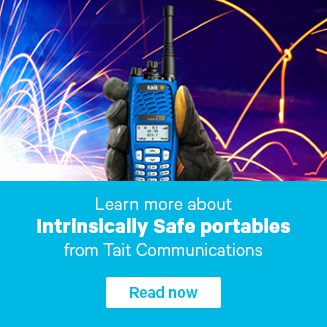Introduction to Intrinsically Safe Radios
Applying Intrinsic Safety
Purchasing and Using IS Equipment
Tips for Purchasers of IS Equipment
- Commission a professional risk analysis and evaluation of the environment in which you operate.
- Identify hazardous materials.
- Determine the probability or frequency of a potentially explosive atmosphere.
- Consider the consequence of ignition – what Equipment Protection Level (EPL) do you require? It may be appropriate to specify equipment with an EPL that is higher (or lower) than the Zone category would normally equate to.
- Investigate which manufacturers offer IS equipment, and what experience similar organizations have had.
- Ensure company operational procedures are up to date and clearly explain the hazards and how the equipment can (or cannot) be used.
- Ensure your workforce are trained and understand the operational procedures.
Batteries and Accessories
As well as the radio itself having an IS rating, all batteries and accessories must also be compliant. If any one part of the radio + battery + accessory system is non-compliant, the whole system is non-compliant and presents a safety risk.
Batteries
Use only specified batteries from the original equipment manufacturer that have ratings matching the radio. Any other battery is unlikely to be IS-compliant and thus presents a real safety risk.
Battery chargers specified by the original equipment manufacturer will be compliant. Any other battery charger is unlikely to be IS-compliant and thus presents a real safety risk.
Accessories
Audio accessories such as speaker microphones also need to match the radio. The radio equipment manufacturer will specify appropriate accessories, including earphones. Entity Parameters’ which define the accessory interface for IS purposes also allow use of other suitable accessories, so assessment should be made by a competent person.
Carry accessories specified by the original equipment manufacturer will be compliant. Carry accessories from other vendors may not be compliant and could present a safety risk.
Programming accessories specified by the original equipment manufacturer will be compliant. Other programming accessories may not be compliant and could present a safety risk.
Tips for Users of Equipment
- Understand your radio and your company procedures – know where you can or cannot use your radio and under what conditions.
- IS radios should be readily identifiable, by conspicuous labels on both the radio and battery and possibly by a distinguishing color (light blue is standard for ATEX equipment).
- Ensure that any accessories also have a suitable IS rating.
- Never remove your portable radio battery in a hazardous environment, or carry a spare battery into that environment, if the label warns against doing so.
- Battery charging must be performed outside of hazardous areas.
- All repairs must be carried out by an approved service facility with appropriate certification.
- The battery is not repairable. If it fails, it must be replaced.
This concludes our series on Intrinsically Safe products. If you need to learn more, we recommend you speak with Industry regulatory bodies, such as Workplace Safety (OHSA), Department of Labour, or the Electrical Safety Regulator.
You can also speak with consultants, your operations staff, and of course, you can contact us here at Tait or post a question in the forums of the Tait Radio Academy.
 Radio Academy
Radio Academy




